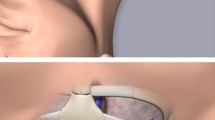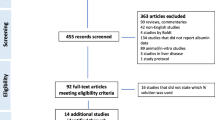Abstract
Purpose: In a prospective randomized study a standard dual-tip hemodialysis catheter (PermCath, Sherwood Medical, St. Louis, MO, USA) was compared with a newer split-lumen catheter (Ash Split, Medcomp, Harleysville, PA, USA).
Methods: Sixty-nine patients (42 men, 27 women; mean age 62 years) were randomized to receive either the Ash Split (AS) or the PermCath (PC) catheter. The catheters were inserted into the internal jugular vein. The primary outcome evaluated was blood flow measurements during the first six hemodialysis sessions. Secondary outcomes included: technical difficulties encountered at insertion, early complications and late complications requiring catheter removal or exchange.
Results: A total of 69 hemodialysis catheters, 33 AS and 36 PC, were successfully inserted in the internal jugular vein (right 60, left 9) of 69 patients. Mean blood flow during dialysis (Qb) was 270.75 ml/min and 261.86 ml/hr for the AS and PC groups respectively (p = 0.27). Mean duration of catheter use was 111.7 days (range 5.4–548.9 days) and 141.2 days (range 7.0–560.9 days) in the AS and PC groups respectively (p = 0.307). Catheter failures leading to removal or exchange occurred in 20 patients: 14 in the AS group and six in the PC group. Survival curves with censored endpoints (i.e., recovery, arteriovenous fistula formation, peritoneal dialysis and transplantation) showed significantly better outcome with PermCath catheters (p = 0.024). There was no significant difference in ease of insertion or early complication rates.
Conclusion: The Ash Split catheter allows increased rates of blood flow during hemodialysis but this increase was not significant at the beginning (p = 0.21) or end (p = 0.27) of the first six hemodialysis sessions. The Ash Split catheter is more prone to minor complications, particularly dislodgment, than the PermCath catheter.




Similar content being viewed by others
References
K Atherikul SJ Scwab PJ Conlon (1998) ArticleTitleAdequacy of haemodialysis with cuffed central-vein catheters Nephrol Dial Transplant 13 745–749
MA Rocklin CA Dwight LJ Callen B Bispham D Spiegell (2001) ArticleTitleComparison of cuffed tunnelled hemodialysis catheter survival Am J Kidney Dis 37 557–563
PA Conz C Crepaldi La Greca (2000) ArticleTitleSlow maturation of arterio-venous fistula seven uremic patients: Use of Ash Split Catheters as temporary, prolonged vascular access J Vasc Access 1 51–53
SR Ash (2001) ArticleTitleThe evolution and function of central venous catheters for dialysis Semin Dial 14 416
NP O’Grady M Alexander E Patchen Dellinger JL Gerberding SO Heard DG Maki H Masur RD McCormick LA Mermel ML Pearson I Raad Issam A Randolp RA Weinstein (2001) ArticleTitleGuidelines for the prevention of intravascular catheter-related infections MMWR 51 IssueIDRR10 1–26
SO Trerotola H Shah MS Johnson M Kraus MA McKusky W Ambrosius VJ Harris JJ Snidow (1998) ArticleTitleTunneled hemodialysis catheters: Use of a silver-coated catheter for prevention of infection—a randomised study Radiology 207 491–496
SO Trerotola MS Johnson VJ Harris H Shah W Ambrosius MA McKusky MA Kraus (1997) ArticleTitleOutcome of tunneled hemodialysis catheters placed via the right internal jugular vein by interventional radiologists Radiology 203 489–495
F Schillinger D Schillinger R Montagnac T Milicent (1991) ArticleTitlePost-catheterisation vein stenosis in haemodialysis: Comparative angiographic study of 50 subclavian and 50 internal jugular accesses Nephrol Dial Transplant 6 722–724 Occurrence Handle1754109
SO Trerotola H Shah MS Johnson J Namyslowski K Moresco N Patel M Kraus C Gassensmith W Ambrosius (1999) ArticleTitleRandomised comparison of high-flow versus conventional hemodialysis catheters J Vasc Interv Radiol 10 1032–1038
GE Cimichowski E Worley WE Rutherford JA Sartain J Blondin H Harter (1990) ArticleTitleSuperiority of the internal jugular over the subclavian access for temporary dialysis Nephron 54 154–161 Occurrence Handle1:STN:280:By%2BC1M7gtlY%3D Occurrence Handle2314526
F Ewing D Patel A Petherick R Winney K McBride (2002) ArticleTitleRadiological placement of the AshSplit haemodialysis catheter: A prospective analysis of outcome and complications Nephrol Dial Transplant 17 614–619
SO Trerotola (2000) ArticleTitleHemodialysis catheter placement and management Radiology 215 651–658
GB Lund SO Trerotola PF Scheel SJ Savader SE Mitchell AC Venbrus FA Osterman SuffixJr (1996) ArticleTitleOutcome of tunneled hemodialysis catheters placed by radiologists Radiology 198 467–472
SO Trerotola M Kraus H Shah J Namyslowski MS Johnson MS Stecker I Ahmed G McLennon NH Patel E O’Brien KA Lane WT Ambrosius (2002) ArticleTitleRandomised comparison of split tip versus step tip high-flow hemodialysis catheters Kidney Int 62 282–289
SP Gibson DA Mosquera (1991) ArticleTitleFive years experience with the Quinton PermCath for vascular access Nephrol Dial Transplant 6 269–274
HM Richard GS Hastings RL Boyd-Kranis et al. (2001) ArticleTitleEvaluation of the Tesio, Ash split, Opti-flow catheters J Vasc Interv Radiol 12 431–435
Author information
Authors and Affiliations
Corresponding author
Rights and permissions
About this article
Cite this article
O’Dwyer, H., Fotheringham, T., O’Kelly, P. et al. A Prospective Comparison of Two Types of Tunneled Hemodialysis Catheters: The Ash Split Versus the PermCath. Cardiovasc Intervent Radiol 28, 23–29 (2005). https://doi.org/10.1007/s00270-003-0230-7
Published:
Issue Date:
DOI: https://doi.org/10.1007/s00270-003-0230-7




